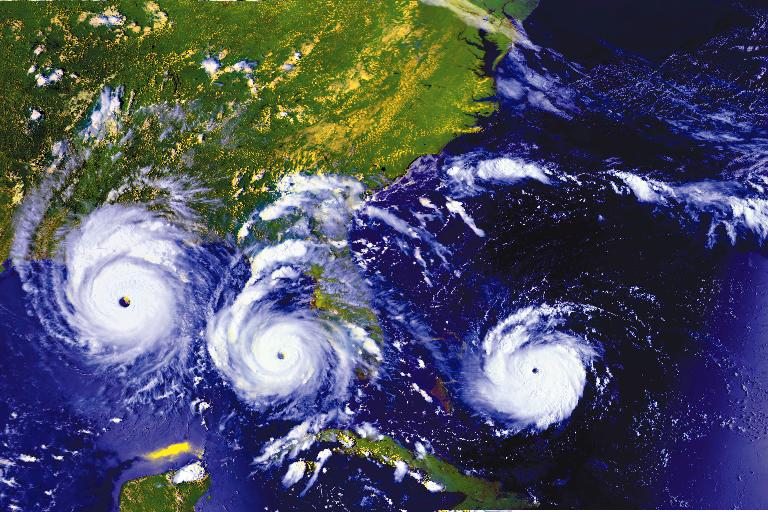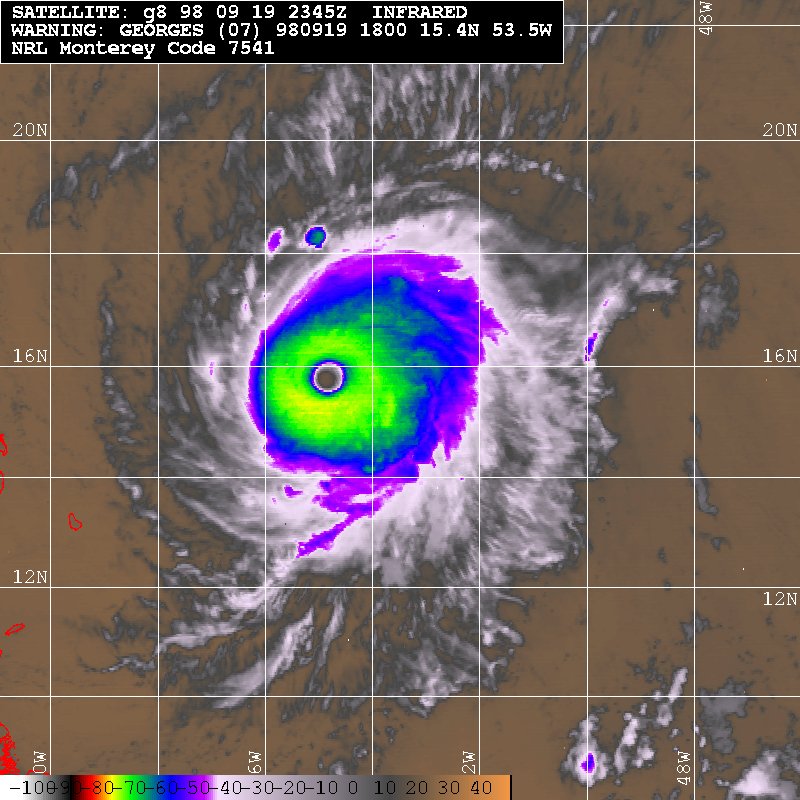|
Hurricane Research Division
The Hurricane Research Division (HRD) is a section of the Atlantic Oceanographic and Meteorological Laboratory (AOML) in Miami, Florida, and is the U.S. National Oceanic and Atmospheric Administration's (NOAA) focus for tropical cyclone research. The thirty member division is not a part of the National Hurricane Center but cooperates closely with them in carrying out its annual field program and in transitioning research results into operational tools for hurricane forecasters. HRD was formed from the National Hurricane Research Laboratory in 1984, when it was transferred to AOML and unified with the oceanographic laboratories. In August, 1992, the AOML/HRD facility sustained moderate damage after the passage of Hurricane Andrew across southern Dade County, Florida, however, despite significant personal disruption to the lives of almost all of its staff members, HRD reconnaissance flights continued into Andrew until it made a final landfall along the Louisiana coastline several day ... [...More Info...] [...Related Items...] OR: [Wikipedia] [Google] [Baidu] |
Atlantic Oceanographic And Meteorological Laboratory
The Atlantic Oceanographic and Meteorological Laboratory (AOML), a federal research laboratory, is part of the National Oceanic and Atmospheric Administration's (NOAA) Office of Oceanic and Atmospheric Research (OAR), located in Miami in the United States. AOML's research spans tropical cyclone and hurricanes, coastal ecosystems, oceans and human health, climate studies, global carbon systems, and ocean observations. It is one of seven NOAA Research Laboratories (RLs). AOML’s organizational structure consists of an Office of the Director and three scientific research divisions. The Office of the Director oversees the Laboratory’s scientific programs, as well as its financial, administrative, computer, outreach/education, and facility management services. Research programs are augmented by Cooperative Institutes, such as the Cooperative Institute for Marine and Atmospheric Studies (CIMAS), a joint enterprise with the University of Miami’s Rosenstiel School of Marine, Atmosphe ... [...More Info...] [...Related Items...] OR: [Wikipedia] [Google] [Baidu] |
National Oceanic And Atmospheric Administration
The National Oceanic and Atmospheric Administration (abbreviated as NOAA ) is an United States scientific and regulatory agency within the United States Department of Commerce that forecasts weather, monitors oceanic and atmospheric conditions, charts the seas, conducts deep sea exploration, and manages fishing and protection of marine mammals and endangered species in the U.S. exclusive economic zone. Purpose and function NOAA's specific roles include: * ''Supplying Environmental Information Products''. NOAA supplies to its customers and partners information pertaining to the state of the oceans and the atmosphere, such as weather warnings and forecasts via the National Weather Service. NOAA's information services extend as well to climate, ecosystems, and commerce. * ''Providing Environmental Stewardship Services''. NOAA is a steward of U.S. coastal and marine environments. In coordination with federal, state, local, tribal and international authorities, NOAA manages the ... [...More Info...] [...Related Items...] OR: [Wikipedia] [Google] [Baidu] |
National Hurricane Center
The National Hurricane Center (NHC) is the division of the United States' NOAA/National Weather Service responsible for tracking and predicting tropical weather systems between the Prime Meridian and the 140th meridian west poleward to the 30th parallel north in the northeast Pacific Ocean and the 31st parallel north in the northern Atlantic Ocean. The agency, which is co-located with the Miami branch of the National Weather Service, is situated on the campus of Florida International University in Westchester, Florida. The NHC's Tropical Analysis and Forecast Branch (TAFB) routinely issues marine forecasts, in the form of graphics and high seas forecasts year round, with the Ocean Prediction Center having backup responsibility for this unit. The Technology and Science Branch (TSB) provides technical support for the center, which includes new infusions of technology from abroad. The Chief, Aerial Reconnaissance Coordination, All Hurricanes (CARCAH) unit tasks planes, for r ... [...More Info...] [...Related Items...] OR: [Wikipedia] [Google] [Baidu] |
National Hurricane Research Laboratory
The National Hurricane Research Laboratory (NHRL) is the hurricane research arm of the National Oceanic and Atmospheric Administration. It was formed in December 1964 out of the National Hurricane Research Project, the U. S. Weather Bureau's effort to scientifically examine tropical cyclones in order to make better predictions. Laboratory status signified that this effort was now a permanent part of the Weather Bureau's activities. History Director R. Cecil Gentry supervised the move of NHRL from the Aviation Building near Miami International Airport, to the newly built Computer Center building on the University of Miami's Coral Gables campus in January 1965. They were accompanied by the Miami hurricane forecast office, and the two combined entities were known, at that time, as the National Hurricane Center (NHC). The 1965 hurricane field program centered on researching Hurricane Betsy. Project STORMFURY made plans to seed Betsy to examine hurricane modification methods, but B ... [...More Info...] [...Related Items...] OR: [Wikipedia] [Google] [Baidu] |
Hurricane Andrew
Hurricane Andrew was a very powerful and destructive Category 5 Atlantic hurricane that struck the Bahamas, Florida, and Louisiana in August 1992. It is the most destructive hurricane to ever hit Florida in terms of structures damaged or destroyed, and remained the costliest in financial terms until Hurricane Irma surpassed it 25 years later. Andrew was also the strongest landfalling hurricane in the United States in decades and the costliest hurricane to strike anywhere in the country, until it was surpassed by Katrina in 2005. In addition, Andrew is one of only four tropical cyclones to make landfall in the continental United States as a Category 5, alongside the 1935 Labor Day hurricane, 1969's Camille, and 2018's Michael. While the storm also caused major damage in the Bahamas and Louisiana, the greatest impact was felt in South Florida, where the storm made landfall as a Category 5 hurricane, with 1-minute sustained wind speeds as high as 165 mp ... [...More Info...] [...Related Items...] OR: [Wikipedia] [Google] [Baidu] |
Dade County, Florida
Miami-Dade County is a county located in the southeastern part of the U.S. state of Florida. The county had a population of 2,701,767 as of the 2020 census, making it the most populous county in Florida and the seventh-most populous county in the United States. It is also Florida's third largest county in terms of land area, with . The county seat is Miami, the core of the nation's ninth largest and world's 34th largest metropolitan area with a 2020 population of 6.138 million people. Miami-Dade County is heavily Hispanic, and was the most populous majority-Hispanic county in the nation as of 2020. It is home to 34 incorporated cities and many unincorporated areas. The northern, central and eastern portions of the county are heavily urbanized with many high-rise buildings along the coastline, including Miami's Central Business District in Downtown Miami. Southern Miami-Dade County includes the Redland and Homestead areas, which make up the agricultural economy of the count ... [...More Info...] [...Related Items...] OR: [Wikipedia] [Google] [Baidu] |
Hurricane Opal
Hurricane Opal was a large and powerful Category 4 hurricane that caused severe and extensive damage along the northern Gulf Coast of the United States in October 1995. The fifteenth named storm, ninth hurricane and strongest tropical cyclone of the unusually active 1995 Atlantic hurricane season, Opal developed from the interaction of a tropical wave and a low-pressure area near the Yucatán Peninsula on September 27 as Tropical Depression Seventeen. The depression crossed the Yucatán Peninsula and intensified into a tropical storm on September 30. Opal intensified into a hurricane on October 2 after entering the Gulf of Mexico. The cyclone turned northeastward and strengthened significantly. By October 4, Opal was an intense 150 mph (240 km/h), Category 4 hurricane. With a minimum pressure of 916 mbar (hPa), Hurricane Opal was the most intense category 4 Atlantic hurricane on record. However, the cyclone abruptly weakened to a low-end Cat ... [...More Info...] [...Related Items...] OR: [Wikipedia] [Google] [Baidu] |
Hurricane Georges
Hurricane Georges () was a powerful and long-lived Cape Verde Category 4 hurricane which caused severe destruction as it traversed the Caribbean and Gulf of Mexico in September 1998, making eight landfalls along its path. Georges was the seventh tropical storm, fourth hurricane, and second major hurricane of the 1998 Atlantic hurricane season. It became the most destructive storm of the season, the costliest Atlantic hurricane since Hurricane Andrew in 1992 and remained the costliest until Hurricane Charley in 2004, and the deadliest since Hurricane Gordon in 1994. Georges killed 604 people, mainly on the island of Hispaniola, caused extensive damage resulting at just under $10 billion (1998 US dollars) in damages and leaving nearly neatly 500,000 homeless in St. Kitts and Nevis, Puerto Rico, Hispaniola and Cuba. The hurricane made landfall in at least six countries (Antigua and Barbuda, St. Kitts and Nevis, Haiti, the Dominican Republic, Cuba, and the United State ... [...More Info...] [...Related Items...] OR: [Wikipedia] [Google] [Baidu] |
2005 Atlantic Hurricane Season
The 2005 Atlantic hurricane season was the most active Atlantic hurricane season in history, until the record was broken 15 years later in 2020. The season broke numerous records at the time, with 28 tropical or subtropical storms recorded. The United States National Hurricane Center named 27 storms, exhausting the annual pre-designated list and resulting in the usage of six Greek letter names, and also identified an additional unnamed storm during a post-season re-analysis. A record 15 storms attained hurricane status, with maximum sustained winds of at least 74 mph (119 km/h); of those, a record seven became major hurricanes, which are a Category 3 or higher on the Saffir–Simpson scale. Four storms of this season became Category 5 hurricanes, the highest ranking on the scale. The four Category 5 hurricanes that developed during the season were: Emily, Katrina, Rita, and Wilma. In July, Emily reached peak intensity in the Caribbea ... [...More Info...] [...Related Items...] OR: [Wikipedia] [Google] [Baidu] |
Hurricane Katrina
Hurricane Katrina was a destructive Category 5 Atlantic hurricane that caused over 1,800 fatalities and $125 billion in damage in late August 2005, especially in the city of New Orleans and the surrounding areas. It was at the time the costliest tropical cyclone on record and is now tied with 2017's Hurricane Harvey. The storm was the twelfth tropical cyclone, the fifth hurricane, and the third major hurricane of the 2005 Atlantic hurricane season, as well as the fourth-most intense Atlantic hurricane on record to make landfall in the contiguous United States. Katrina originated on August 23, 2005, as a tropical depression from the merger of a tropical wave and the remnants of Tropical Depression Ten. Early the following day, the depression intensified into a tropical storm as it headed generally westward toward Florida, strengthening into a hurricane two hours before making landfall at Hallandale Beach on August 25. After briefly weakening to tropical storm strength o ... [...More Info...] [...Related Items...] OR: [Wikipedia] [Google] [Baidu] |
Aircraft Operations Center
The Aircraft Operations Center (AOC) is the main base for the approximately nine aircraft of the National Oceanic and Atmospheric Administration of the United States government. It is the home of the NOAA Hurricane Hunters. The NOAA Aircraft Operations Center houses multiple light aircraft, and three Hurricane Hunters aircraft. This base plays a large role every hurricane season, supporting NOAA flights in and around tropical cyclones for research and forecasting. The Aircraft Operations Center, located at Lakeland Linder International Airport in Lakeland, Florida, since June 2017, is under the Office of Marine and Aviation Operations (OMAO), a branch of the National Oceanic and Atmospheric Administration (NOAA). NOAA is part of the Department of Commerce. The AOC resided at MacDill Air Force Base in Tampa, Florida, from January 1993 to June 2017. Aircraft * Two WP-3D Orion - heavily instrumented turboprops used for hurricane hunting * One Gulfstream IV-SP (G-IV) - twin tur ... [...More Info...] [...Related Items...] OR: [Wikipedia] [Google] [Baidu] |







